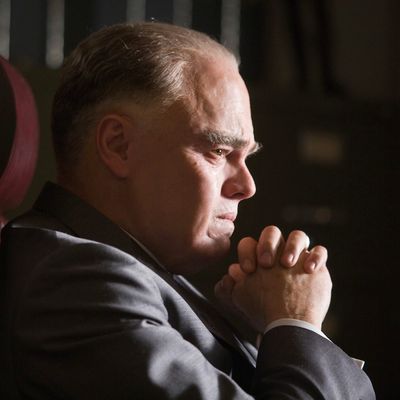
This post contains spoilers for On Chesil Beach.
Walking into the the new adaptation of On Chesil Beach, you know you’ll get at least one palm-sweatingly uncomfortable scene: the fumbling, abortive attempt at wedding-night sex that, as all readers of Ian McEwan’s novel know, eventually tears apart the young lovers Edward and Florence (Billy Howle and Saoirse Ronan). But there’s another scene that’s only slightly less awkward. As in McEwan’s book, the movie’s coda skips forward to 2007, when Florence and Edward are both in their late 60s. Edward, who has never married, hears on the radio that Florence’s string quartet is playing the concert hall she’d dreamed of performing at in her youth, so he shows up and buys a ticket for the exact seat he’d told her he’d be sitting in 45 years earlier. The concert finishes, and as the crowd gives a standing ovation, the pair lock eyes. It’s a beautiful moment — marred slightly by the fact that the filmmakers have decided not to cast older actors for the sequence, but instead pile lots of old-age makeup atop Saoirse Ronan and Billy Howle’s bright, dewy faces. Believe me, you haven’t lived until you’ve seen Lady Bird pretending to be a 67-year-old violinist. As Ronan told Ryan and Kelly, “I’m all wrinkly.”
I am here not to criticize the makeup job itself, which is pretty good as far as film makeup goes, if a bit ill-suited to the emotional demands of the moment. But watching that scene, I couldn’t help thinking of the other Ian McEwan adaptation with Saoirse Ronan — 2007’s Atonement, where the tweenage Ronan got her big break playing the youngest version of a character also played by Romola Garai and Vanessa Redgrave. (The resemblance between the three actresses is not super strong, which is why the movie gave them all the same haircut.)
In Atonement, Ronan was taking part in a hallowed Hollywood tradition, in which up-and-comers got their starts playing child versions of adult stars. Think Wil Wheaton and Richard Dreyfuss in Stand by Me, River Phoenix and Harrison Ford in Last Crusade, or Michael Angarano and Tobey Maguire in Seabiscuit. Sometimes, as in 1995’s Now and Then, this was the entire premise of the movie. And adults could get in on the fun, too. Rob Lowe played a young Robert Wagner in Austin Powers: The Spy Who Shagged Me. Gloria Stuart got an Oscar nomination for playing old Kate Winslet in Titanic. Josh Brolin came aboard the Men in Black franchise to play a younger Tommy Lee Jones in MIB3. (We’re not just talking about good movies today.) This was a system that worked out for everyone — actors got parts, casting directors got fun challenges, and audiences got to see stars’ actual faces.
Sadly, this tradition seems to be dying out, and you can blame the same thing that’s killing all the other remnants of our messily analog past — technology. More and more, it seems like movies are using makeup and CGI to avoid recasting actors for different ages. I blame two films. First was 2009’s Benjamin Button, whose state-of-the-art makeup and special effects showed the rest of Hollywood just how convincingly an A-lister could be turned into an old man, or even a baby. Second was 2015’s Ant-Man, which opened with a digitally de-aged Michael Douglas, basically just to show off.
The aging and de-aging effects in both of those films were jaw-dropping (or maybe I should say “jowl-dropping”), but as the same techniques spread out to the rest of the industry, they’ve become a crutch. Digital de-aging, in particular, has become to movies what Auto-Tune was to late-2000s rap — occasionally done artfully, but more often a way to spice up something otherwise lacking in flavor. I can see the case for Young Kurt Russell in Guardians of the Galaxy 2, but Teenage Robert Downey Jr. in Captain America: Civil War, 20-something Johnny Depp in Pirates of the Caribbean: Dead Men Tell No Tales, and Middle-Aged Anthony Hopkins in Westworld all play like VFX artists flexing for the sake of flexing. (Oddly enough, Westworld famously recasts another pivotal role with a younger actor for flashbacks, but I guess the temptation to digitally resurrect Remains of the Day–era Hopkins was too good to resist.) If Looper was made today, it’s a solid bet they would have just de-aged Bruce Willis for the Joseph Gordon-Levitt parts.
Makeup in theory is less objectionable. (Even Remains of the Day subtly styled Hopkins and Emma Thompson to look older in the postwar scenes.) But as in On Chesil Beach, I can think of countless moments when old-age makeup is not up to what’s being demanded of it. Consider J. Edgar, where youthful hunks Leonardo DiCaprio and Armie Hammer were turned into the septuagenarians only slightly more realistic than Statler and Waldorf. Or This Is Us, where Sterling K. Brown’s best acting is pretending Mandy Moore looks anything like a normal middle-aged woman.
I don’t think the Hollywood is going purposefully out of its way not to recast parts for age anymore; rather, like a kid on Christmas, filmmakers are just infatuated with their new toys. Even Martin Scorsese, a director as respectful of history and tradition as anyone in the business, has caught the fever: He’s currently at work on The Irishman, a $140 million Netflix film that is spending much of its hefty budget digitally de-aging Robert De Niro to make him look 30 years younger. De Niro, of course, broke out playing the younger version of Marlon Brando’s character in The Godfather Part II. Shouldn’t someone else get that same chance?


